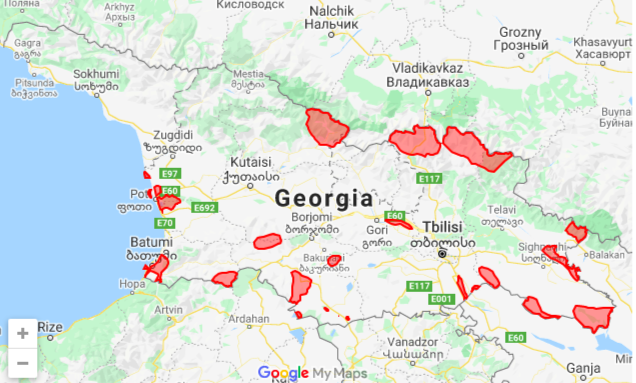Taxonomy
Kingdom Animalia (16266)Phylum Chordata (708)
Class Aves (404)
Order Anseriformes (31)
Family Anatidae (31)
Genus Melanitta (2)
Species Melanitta fusca
Browse by taxonomy
Simple search by name
Melanitta fusca ✓
Velvet Scoter, თეთრფრთიანი გარიელი
Name According To: http://datazone.birdlife.org/species/taxonomy
Species: fusca
Taxon Rank: Species
Scientific Name Authorship: Linnaeus, 1758
Vernacular Name: Velvet Scoter
Georgian Name: თეთრფრთიანი გარიელი
GBD Remarks:
The populations of Velvet Scoter (Melanitta fusca) is decreasing worldwide and the species is classified as Vulnerable by IUCN and included on The Red List of Georgia as Endangered. Within the Western Palearctic two populations are recognized: large population of northern Europe and western Russia and the small, isolated population in Georgia, Turkey and Armenia. Not long ago the breeding area of Velvet Scoter included several lakes of Javakheti plateau (Saghamo, Paravani, Khanchali, Kartsakhi and Tabatskuri), South Georgia. However, breeding area of Velvet Scoter is critically reduced and currently the species only remains in Tabatskuri Lake.
Tabatskuri Lake is located in Samtskhe-Javakheti region, Georgia. 2000 meters from sea level. The Surface area - 14.2 Km2. The average depth is 15 m. There is a small island, which is breeding place for Velvet Scoter.
The Tabatskuri lake is recognized as an important bird area by the Birdlife International.
IDENTIFICATION
The length of the Velvet Scoter body is about 51 - 58 cm from the tip of the nail to the end of the tail. Wingspan: 79 - 97 cm Weight: 1.3 - 1.9 kg. The male is biger then female. Male (definitive basic): All-black plumage, except the wing (secondaries white) and head, which has a white patch that surrounds the eye. Iris whitish to pale blue-grey. Bill-sides largely bright yellow, nail ivory, periphery of nostrils, upper culmen and tomium are black. Legs are reddish. Female (definitive basic): Similar to male, but browner and duller. Head lacks white patch, but there are two diffuse pale areas, at the bill base and on the ear coverts. Iris dark brown. Bill dark grey. Juvenile is very similar to female. Habitat: Shores, freshvater lakes, ponds and large rivers in the taiga. Lakes in the subalpine zone of the Caucasus. Food: Molluscs and crustaceans are the most common food. Nests on the ground close to water, and hidden by brush. Breeding starts in June. Clutch size is normally 7 – 10 eggs. Incubation: 25 – 30 days. Fledging: 50 – 60 days. Maturity: 2 – 3 years. Lifespan: 7 – 8 years
Page Authors: Nika Paposhvili ,
Georgian biodiversity database contains 1 occurrences of Melanitta fusca
| Occurrence ID | Basis of Record | Locality | Recorded By | Decimal Latitude | Decimal Longitude |
| 6703 | Tabatskuri Lake | 41.658774° | 43.634586° |
Information from GBIF about Melanitta fusca
GBIF scientific name: Melanitta fusca (Linnaeus, 1758)
GBIF taxonomic status: ACCEPTED

Conservation Status
This section is under construction
National Red List Status: CR A2abcde+3cde+4bcde;B1ab(iii,iv,v)+2ab(iii,iv,v);C1+2a(ii)
IUCN Red List Status: VU A2abcde+3cde+4bcde
Protection status: Not defined
Reason: A2
Trend: Declining
EOO: <100
AOO: <10
Native/Introduced: Native
Comment: პოპულაციის რიცხოვნობა შემცირებულია და არსებობს საფუძველი, რომ ვივარაუდოთ (A2) საქართველოში ამ სახეობის რიცხოვნობის 80%-ზე მეტით შემცირება ბოლო 10 წლის ან სამი თაობის განმავლობაში. ამასთან, შემცირების მიზეზები შეიძლება ამჟამადაც არსებობდეს ან ბოლომდე არ იყოს შესწავლილი ან იყოს შეუქცევადი, რაც ემყარება ქვემოთ მოცემულ კრიტერიუმებს a-დან e-მდე; (A3) პოპულაციის რაოდენობის მოსალოდნელი ან სავარაუდო 80%-ზე მეტით შემცირება მომდევნო 10 წლის ან სამი თაობის განმავლობაში, რაც ემყარება ქვემოთ მოცემულ კრიტერიუმებს c-დან e-მდე; (A4) რიცხოვნობის გამოკვლეული, გამოთვლილი, სავარაუდო, მოსალოდნელი ან საეჭვო 80%-ზე მეტით შემცირება ნებისმიერი ათი წლის ან სამი თაობის განმავლობაში. დროის ეს პერიოდი უნდა მოიცავდეს წარსულსაც და მომავალსაც, სადაც რიცხოვნობის შემცირების მიზეზი შეიძლება ამჟამადაც მოქმედებდეს ან არ იყოს შესწავლილი ან იყოს შეუქცევადი, რაც ემყარება ქვემოთ მოცემულ კრიტერიუმებს b-დან e-მდე.(a)პირდაპირი დაკვირვება.(b)ტაქსონის შესაბამისი სიმრავლის ინდექსი.(c)დაკავებული არე (AOO), გავრცელების არე (EOO) ან/და ჰაბიტატის ხარისხის გაუარესება.(d)ექსპლუატაციის რეალური ან პოტენციური დონე.(e)შემოყვანილი ტაქსონების, ჰიბრიდიზაციის, პათოგენების, დამაბინძურებლების, კონკურენტების ან პარაზიტების ზემოქმედება. B. გეოგრაფიული არეალი შემცირებულია და არსებობს საფუძველი ვივარაუდოთ (B1) დაკავებული არე (AOO) 100 კმ2-ზე ნაკლებია და არსებობს ქვემოთ მოცემული (a) და (b) წინაპირობები;(B2) გავრცელების არე (EOO) 10 კმ2-ზე ნაკლებია და არსებობს ქვემოთ მოცემული (a) და (b) წინაპირობები.(a)არეალი ძალიან დანაწევრებულია ან ერთ ლოკაციას წარმოადგენს.(b)არეალის გამოკვლეული, სავარაუდო ან მოსალოდნელი უწყვეტი შემცირება, რაც მოიცავს: iii - ჰაბიტატის ფართობს, ფარგლებს ან/და ხარისხს; iv - გავრცელების ლოკაციების ან ქვეპოპულაციების რაოდენობას; v - ზრდასრული ინდივიდების რიცხვს. C. პოპულაციის რიცხოვნობა 250 ინდივიდზე ნაკლებია და არსებობს საფუძველი ვივარაუდოთ (C1) გამოკვლეული, მოსალოდნელი ან სავარაუდო უწყვეტი კლება არა ნაკლებ 25%-სა სამი წლის ან ერთი თაობის განმავლობაში; (C2) გამოკვლეული, მოსალოდნელი ან სავარაუდო უწყვეტი კლება და ქვემოთ მოყვანილი a(ii) გარემოება.a(ii) ზრდასრული ინდივიდების არანაკლებ 90-100% ერთ ქვეპოპულაციაშია.
Georgian Name: თეთრფრთიანი გარიელი
English Name: Velvet Scoter
Taxonomy according to: http://datazone.birdlife.org/species/taxonomy
References: IUCN. (2012). IUCN Red List Categories and Criteria: Version 3.1. Second edition. Gland, Switzerland and Cambridge, UK: IUCN. iv + 32pp./BirdLife International./BirdLife International. 2018. Clangula hyemalis. The IUCN Red List of Threatened Species 2018:
Evaluated By: Paposhvili N, Javakhishvili Z, Gavashelishvili A, Abuladze A, Javakhishvili N, Dekanoidze D, Ninua L, Mamuchadze J, Shoshitashvili D, Kandaurov A.
Date evaluated: Nov 2021





